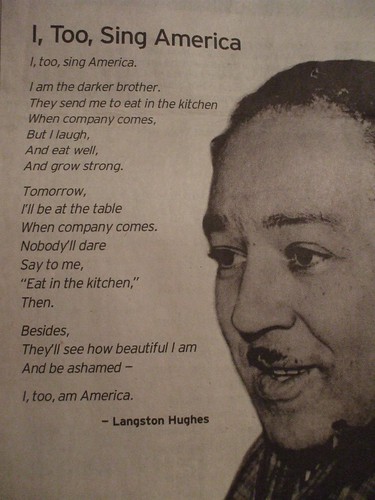Langston Hughes
James Langston Hughes was born February 1, 1902, in Joplin, Missouri. His
parents divorced when he was a small child, and his father moved to Mexico. He
was raised by his grandmother until he was thirteen, when he moved to Lincoln,
Illinois, to live with his mother and her husband, before the family eventually
settled in Cleveland, Ohio. It was in Lincoln, Illinois, that Hughes began
writing poetry. Following graduation, he spent a year in Mexico and a year at
Columbia University. During these years, he held odd jobs as an assistant cook,
launderer, and a busboy, and travelled to Africa and Europe working as a seaman.
In November 1924, he moved to Washington, D.C. Hughes's first book of poetry,
The Weary Blues, was published by Alfred A. Knopf in 1926. He finished
his college education at Lincoln University in Pennsylvania three years later.
In 1930 his first novel, Not Without Laughter, won the Harmon gold
medal for literature.
Hughes, who claimed
Paul Lawrence Dunbar,
Carl Sandburg, and
Walt Whitman as his
primary influences, is particularly known for his insightful, colorful
portrayals of black life in America from the twenties through the sixties. He
wrote novels, short stories and plays, as well as poetry, and is also known for
his engagement with the world of jazz and the influence it had on his writing,
as in "Montage of a Dream Deferred." His life and work were enormously important
in shaping the artistic contributions of the Harlem Renaissance of the 1920s.
Unlike other notable black poets of the period—Claude McKay, Jean Toomer, and
Countee Cullen—Hughes refused to differentiate between his personal experience
and the common experience of black America. He wanted to tell the stories of his
people in ways that reflected their actual culture, including both their
suffering and their love of music, laughter, and language itself.
Langston Hughes died of complications from prostate cancer in May 22, 1967,
in New York. In his memory, his residence at 20 East 127th Street in Harlem, New
York City, has been given landmark status by the New York City Preservation
Commission, and East 127th Street has been renamed "Langston Hughes Place."
In addition to leaving us a large body of poetic work, Hughes wrote eleven
plays and countless works of prose, including the well-known “Simple” books:
Simple Speaks His Mind, Simple Stakes a Claim,Simple Takes
a Wife, and Simple's Uncle Sam. He edited the anthologies The
Poetry of the Negro and The Book of Negro Folklore, wrote an
acclaimed autobiography (The Big Sea) and co-wrote the play Mule
Bone with Zora Neale Hurston.
By Langston Hughes
There’s hanging moss
And holly
And tall straight pine
About this little cabin
In the wood.
Inside
A crackling fire,
Warm red wine,
And youth and life
And laughter
That is good.
Outside
The world is gloomy,
The winds of winter cold,
As down the road
A wandering poet
Must roam.
But here there’s peace
And laughter
And love’s old story told
Where two people
Make a home.
Barn architecture in Tennessee: Langston Hughes Library by Maya Lin:
"The Langston Hughes Library is a private
non-circulating library designed by Maya Lin (most famous for her Vietnam
Veteran’s Memorial in Washington DC), and located on the Haley Farm in Clinton,
TN. It contains a 5,000-volume reference collection focusing on works by
African-American authors and illustrator, and books focused on the Black
experience.…
An 1860s refurbished barn and two corn cribs comprise
the exterior skin of the building. The rustic exterior, which evokes the
'architectural vernacular of 19th-century East Tennessee, a plain language of
silvery, time-worn siding, rough logs, and minimal geometries,' is melded with
modern Shaker-like simplicity on the interior.
Maya Lin pointed out that the function of the exterior
and that of the interior were different and thus she 'wanted to make a real cut
between outside and inside…there didn't seem to be much point in preserving the
rustic feel of the barn's interior.'
…A striking aspect of the design (is) the glass-encased
corn cribs that act as a base for the cantelievered barn that sits atop them.
Margaret Butler of Martella Associates states that the glass between the logs
'glows like a Chinese lantern' at night…"
http://www.poets.org/poet.php/prmPID/83





2 comentarios:
Hola
Encontré un canal de youtube con una emocionante traducción del poema Negro de Langston Hughes
https://youtu.be/qVYGXSsG100
Gracias amigo por tu colaboración
Publicar un comentario